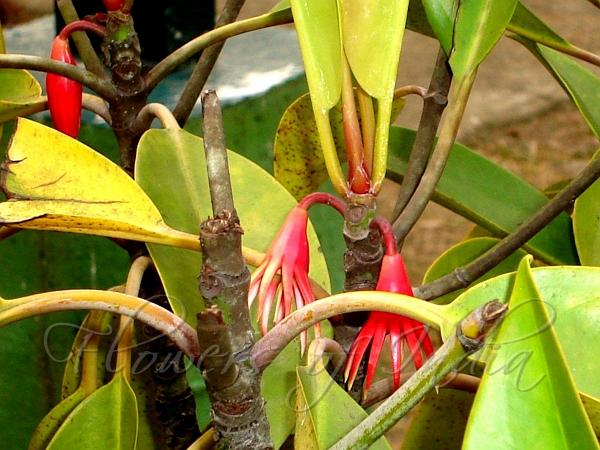|
| Burma Mangrove |
|

|

|
|
|
|
Photo: |
Botanical name: Bruguiera gymnorhiza Family: Rhizophoraceae (Burma Mangrove family)
Synonyms: Bruguiera capensis, Bruguiera conjugata, Bruguiera wightii
Synonyms: Bruguiera capensis, Bruguiera conjugata, Bruguiera wightii
Burma Mangrove is an evergreen tree, 8–25 m tall,
with a straight trunk 40–90 cm in diameter, buttressed at base, and
with many upright air-filled roots rising to 45 cm from long horizontal
roots. Bark is gray to blackish, smooth to roughly fissured, thick.
Inner bark is reddish. Oppositely arranged elliptical leaves, 9–20 cm
long, 5–7 cm wide, are narrow at both ends, thick, leathery, and
hairless. Leaf stalks are 2–4.5 cm long. Flowers arise solitary in leaf
axils, 3–4 cm long, usually drooping on a stalk of 1–2.5 cm, red to
yellowish or cream-colored, with red to pink-red bell-shaped sepal cup.
Flowers have 10–14 very narrow, leathery sepals. Petals are 10–14,
1.3–1.5 cm long, white, turning brown, each with 2 narrow lobes ending
in 3–4 bristles. Stamens are 2, nearly hidden, at base of each petal.
When mature, the spindle-shaped fruits drop and become embedded in the
mud in an upright position, where they rapidly develop roots. Burma
Mangrove is found in India and parts of SE Asia.
| Identification credit: Ratna Ghosh | Photographed in Sunderban, West Bengal & Andaman & Nicobar. |
• Is this flower misidentified? If yes,